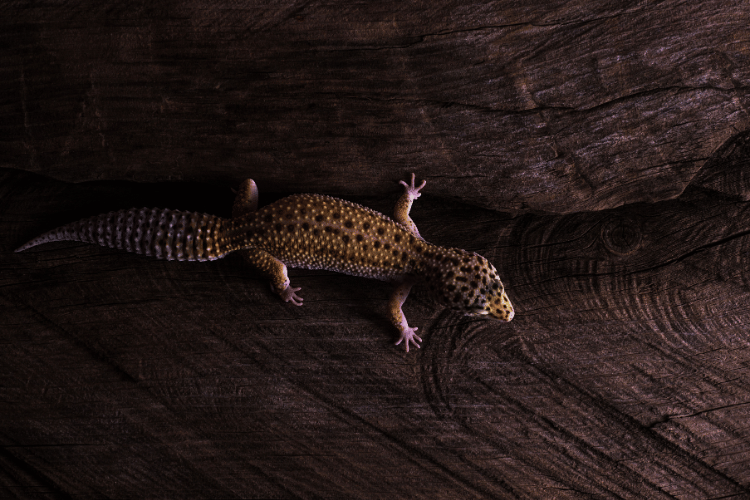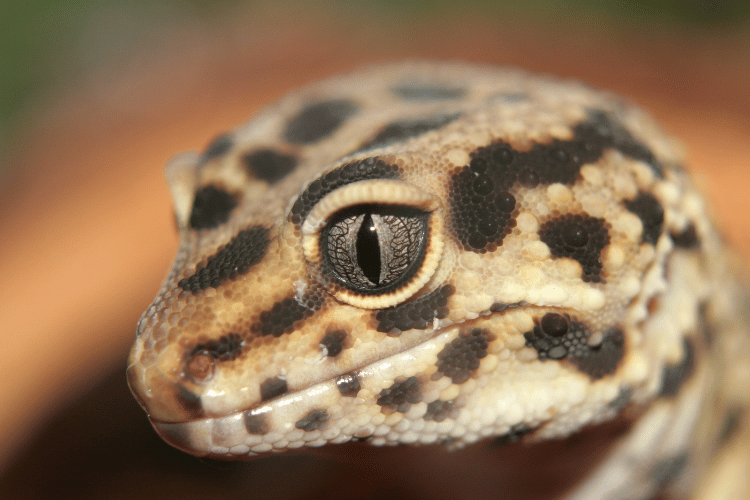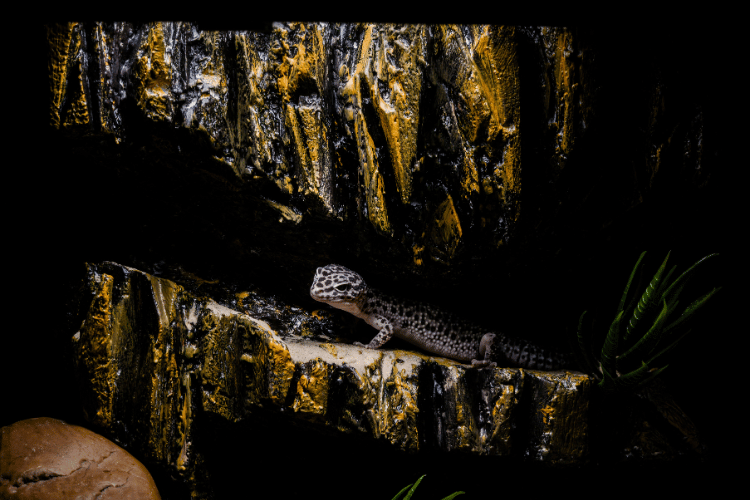Whether it’s their affordable faces, gentle nature, or excellent adaptability, there are tons of reasons to fall in love with Leopard Geckos!
If you have a Leopard gecko, you might notice that it can navigate perfectly among non-moving objects, even in complete darkness. So, can Leopard Geckos see in the dark?
Leopard Geckos are blessed with incredible night vision, which allows them to see several hundred times better at night and in dim light conditions than we do. Not only that but they can also differentiate colors at night.
If you want to find out more about this amazing ability and the reasons behind it, this guide will walk you through everything you need to know. So without further ado, let’s dive right in!

How Well Can Geckos See at Night?
Leopard geckos have excellent vision that allows them to see clearly in low-light conditions. In fact, Leopard Gecko’s night vision and sensitivity are calculated to be around 350 times stronger than ours.
One thing you should know here is that this is not exclusive to Leopard Geckos alone, as many other Gecko species share this excellent eyesight, according to a recent study of the agile lizards.
In fact, the same study mentions that geckos’ vision allows them to find their way and distinguish foreign-object in their surroundings even at moonless nights or ultra-dim lighting levels.
What Colors Can Leopard Geckos See?
Contrary to some people’s belief, Leopard geckos are not colorblind. However, their color perception range is quite different from ours.
While our cone cells can differentiate red, green, and blue, geckos’ color spectrum is relatively limited, as they’re mainly sensitive to yellow and green color spectrums.
This allows them to distinguish between different shades of brown, green, and yellow, but struggle to differentiate shades of red and other colors that we can see.
However, what Leopard Geckos lack in terms of variety, they make up for in terms of visual intensity.
For instance, we have an extremely limited ability to differentiate colors in darkness, so we see everything in shades of gray and white. Yet, Geckos not only see clearly at night, but they can also see in bright colors!
This is a rather unique aspect of geckos, as most other nocturnal animals who have good night vision don’t have good color differentiation.
Reasons Behind Leopard Geckos’ Excellent Night Vision
Now that you know more about Gecko’s exceptional eyesight you might be wondering about the reasons behind such impeccable night vision, and that’s where this section comes in handy!
Here’s a quick look at all the different reasons why Leopard Geckos have such good night vision:
Relatively Large and Bulging Eyes
One of the most characteristic aspects of geckos is their relatively large eyes. In fact, gecko’s eyes are almost as large as their head and take up the majority of their skulls, especially small species like Leopard Geckos.
The relatively large size and bulging structure means a larger surface area for light to fall on, and therefore, better sensitivity to light. In other words, they need very little light to see clearly in the dark.
Additionally, the structure of their eyes gives geckos special peripheral visions that give them a wider view range and the ability to collect light rays from different angles. This also increases their ability to escape predators and advance on prey.
Enhanced Cone Cells
First, you need to know that there are two types of sensory cells that detect light, which are known as rods and cones.
The main difference between the two is that rod cells are more sensitive to light but can’t distinguish colors while cones are much better at distinguishing colors but they only work in bright lights.
Based on what you now know, you might think that Leopard Geckos have an abundance of rod cells, which explains their excellent night vision. Surprisingly, however, Leopard Geckos don’t have any rod cells!
This is because Leopard Geckos evolved from true lizards that only hunt during the day, so they only have cone cells.
Geckos overcame these biological hurdles by greatly mutating their cone cells, which evolved into 3 different types:
- Short-wavelength sensitive cones
- Middle-wavelength sensitive cones
- Long-wavelength sensitive cones
These enhanced and oversized cone cells allowed them to see various colors, especially blue, green, and yellow light, with excellent clarity, even in extremely dim light.
Multifocal Lenses

Another unique feature that allows Leopard geckos to see clearly at night is their multifocal lenses.
As the name suggests, the lenses are made up of several special layers, allowing each one to focus on different light wavelengths separately.
This further improves the geckos’ ability to view colors in high contrast, even in low-light conditions.
Light Amplifying Retinas
Leopard geckos are crepuscular species native to the desert regions of Asia and the middle east. These regions are quite hot during the day, so their activity level is at its peak during dusk and dawn.
This is when there is just enough light for them to see clearly, but not so much that it would make them easy to locate by predators or too obvious to prey.
This is all thanks to a special reflective layer that sits behind their retina, known as “tapetum lucidum”.
This layer allows Leopard geckos to greatly amplify the amount of light they receive, making even the dimmest light enough for their cone photopigments to do their job.
Do Geckos Have Thermal Vision?
Thermal vision is the ability to distinguish infrared wavelengths, which allows some animals to distinguish heat associated with these rays.
Although gecko species generally have great vision, whether during the day or night, they don’t have the photosensors necessary for thermal vision.
With that being said, thermal vision is quite common among several reptile species, especially snakes.
Besides snakes, other animal and insect species that have this unique ability are beetles, mosquitoes, and some bats.
Do Leopard Geckos React to Specific Colors?
Although Leopard Geckos can distinguish many colors, there isn’t any scientific evidence that shows their attraction to a specific color over the other.
Similarly, Leopard Geckos don’t seem to be irritated by any colors, so you don’t have to worry about that either.
However, some pet owners claim that their Leopard Geckos are attracted to certain shades of blue and green.
Do Lights Disturb Leopard Geckos?
Different gecko species have unique activity cycles, as some of them have a nocturnal lifestyle, while others (including Leopard Geckos) are crepuscular.
However, in both cases, geckos are adapted to relatively low light at night, so you should avoid keeping them in bright lights, as it can disrupt their sleeping cycles (circadian rhythm), which can have negative effects on their health.
This doesn’t apply to infrared heat lamps and UV light, as they need that light to keep them warm during cold winter. The lamp should still be quite dim, especially at night.
What About Other Leopard Gecko Senses?
Although the Leopard gecko’s vision is one of its most characteristic aspects, you might be interested in finding out more about its other senses, so here’s a quick look at each one of them:
Hearing
Leopard geckos have a keen sense of hearing, as they’re adapted to quiet environments. However, gecko’s hearing range is fairly limited compared to humans.
Like lizards, they have an audible range of between 100 to 4,000 Hertz, compared to our 20 to 20,000 Hertz range.

Smelling
Smelling is necessary for geckos’ survival in the wild. They have a decent ability to pick up scents and recognize them.
This is why geckos often recognize their favorite and least favorite food and react accordingly.
Touch (Tactile Sensitivity)
Leopard Geckos are quite sensitive to touch and can pick up vibrations from their surroundings. This is essential for catching their prey, which are usually extremely tiny to make any noise.
What to Do If Your Leopard Gecko Has Eye Issues
As you can see, Leopard Geckos have good eyesight in different light conditions. If you’ve noticed that your pet gecko is bumping into non-moving objects in its closure, this can be a sign that it suffers from ocular issues.
In fact, Leopard Geckos are prone to various familiar eye problems, such as conjunctivitis, Pinkeye, eye ulcers, and more.
The most common culprit for these problems is contaminated substrate, such as mulch, fine sand, peat moss, etc, especially when it’s lodged beneath their eyelids. Besides contaminants, unshed skin under the eye can also cause vision problems.
Luckily, your local vet can help your gecko with these problems by cleaning their eyes and prescribing pain relievers, antibiotics, and anti-inflammatory medications.
Keep in mind that malnutrition can also affect your gecko’s eye development, especially the lack of vitamin A and vitamin D3. In that case, the vet might recommend dietary supplements to speed up recovery.
Wrap Up
Leopard geckos are amazing creatures with various unique abilities and aspects. Besides its attractive skin pattern and gentle temperament, it also has exceptionally good night vision!
The secret behind gecko’s unique vision is their transmuted cone cells that can differentiate colors even in extremely low light.
This also means that geckos are adapted to low light, so you should avoid subjecting your gecko to extremely bright light, especially during the night, as it can mess up their circadian rhythm.
- Can Leopard Geckos Eat Silkworms? - March 11, 2024
- Do Leopard Geckos Climb? - March 4, 2024
- Do Leopard Geckos Bask? The Answer Will Surprise You - February 21, 2024
